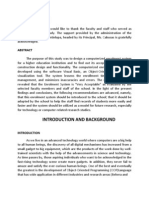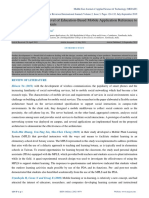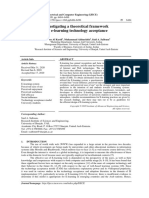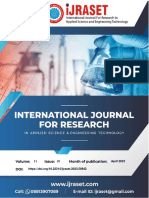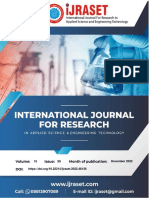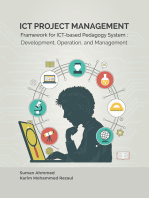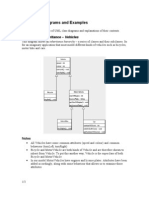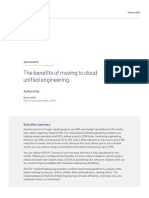Professional Documents
Culture Documents
An Assessment of Students' Perception of Institution Websites and Portals For Academic and Information Purposes
Original Title
Copyright
Available Formats
Share this document
Did you find this document useful?
Is this content inappropriate?
Report this DocumentCopyright:
Available Formats
An Assessment of Students' Perception of Institution Websites and Portals For Academic and Information Purposes
Copyright:
Available Formats
Volume 7, Issue 12, December – 2022 International Journal of Innovative Science and Research Technology
ISSN No:-2456-2165
An Assessment of Students' Perception of
Institution Websites and Portals for Academic
and Information Purposes
Eboka, Andrew Okonji, Onyemenem Sunday Innocent
Department of Computer Science Education, School of Secondary Education Science
Federal College of Education (Technical) Asaba, Nigeria
Anthony NdubuisiAchi
Department of Education, School of Secondary Education,
Federal College of Education (Technical) Asaba, Nigeria
Onyema Lizzy Nkem
Department of Office Technology and Management Education,
School of Secondary Education (Business)
Federal College of Education (Technical) Asaba,
Nigeria
Abstract:- The usage of the Internet by international I. INTRODUCTION
companies to connect with and engage both existing and
potential customers has increased in the twenty-first With the advent of the global pandemic in late 2019,
century, regardless of hurdles like geographic separation most organizations around the world have embraced the
and time zone variations. As a result, the use of digital reality of telecommuting or remote work as the new normal.
products has dramatically increased. Thus, the This approach was adopted to stem the spread of the
usefulness of a digital product as determined by user coronavirus while ensuring that organizational activities
ratings is crucial. An evaluation of usability aims to elicit were not ground to a halt (Bruinen de Bruin et al., 2020).
consumers' opinions about a specific digital product. To This work-from-home policy has led to an upsurge in the
establish standards, John Brooke created the Software use of software applications and digital hardware devices in
Usability Scale (SUS), which measures how consumers workplaces, homes, and academia (De’ et al., 2020; Pedro,
perceive the usability of digital goods. This research 2020). To avert the future disruption of academic activities
seeks to ascertain the perception of students in Federal by most educational institutions in Nigeria (where an entire
College of Education (Technical), Asaba on the use of the academic session was lost as most institutions couldn’t
College portal and website for academic and adopt or develop appropriate strategies to address the issue),
informational purposes. Our study makes use of a the Federal Government of Nigeria in collaboration with the
descriptive survey design with three research questions, Tertiary Education Trust Fund (Tetfund) began an extensive
with a sample size of one hundred and fifty (150) collaboration with relevant stakeholders, agencies of
students drawn at random from the several government and the organized private sector to create
departments. For the purpose of gathering information, electronically driven technologies to address core
a survey titled "Students Perception on the Increased administrative and academic activities in most tertiary
Use of the College Website and Portal (SPIUCWP)" was institutions (e.g. course registration, teaching and learning,
employed. As a model for creating the questionnaire, the library services, result computation, and transcript
System Usability Scale was used. To examine the data generation). This was meant to mitigate future global
gathered, mean and standard deviation were employed. challenges. In a bid to adopt technology as a means of
The majority of students criticized the current static curtailing the harmful effects of similar challenges in the
nature of the College website considering it to be little future, an enormous leap in the budget provision for ICT
essence to both the college and students. With an average development from about three hundred and thirty million
mean over 2.50, it was obvious that most respondents naira (N330, 000, 000:00) in 2019 (Tetfund, 2019) to over
were willing to regularly engage with a more vibrant and two billion naira (N2, 000, 000, 000:00) in 2020 (Tetfund,
user-friendly website that can encourage remote 2020).
learning and other information services relevant to their
academic. A key suggestion for this study was the In order to guarantee user satisfaction with the usage
redesign of the current college website and portal to of software applications and digital devices, the System
make it more dynamic and user-friendly. Usability rating was created. The System Usability Scale
was the most commonly adopted grading system created by
several regulatory agencies (Lewis & Jeff, 2009;
Ojugo&Otakore, 2018). Due to its apparent simplicity in the
evaluation of digital devices, the System Usability Scale
(SUS) has been a well-researched and widely used survey
IJISRT22DEC1525 www.ijisrt.com 2006
Volume 7, Issue 12, December – 2022 International Journal of Innovative Science and Research Technology
ISSN No:-2456-2165
instrument (Armbrust et al., 2009). Currently, there are a lot confidence is increased, and their learning is improved
of usability evaluation tools available, however the most of when a site can adapt. Additionally, it motivates them to
them need payment (Albert & Tom, 2013; Brooke, 1996) visit the website more frequently. The usability of a
and are designed to examine clients' subjective assessments website should therefore be evaluated from the
of systems. The System Usability Scale (SUS) has largely viewpoint of the user (Björneborn & Ingwersen, 2004).
been accepted by researchers as a valid method of obtaining
user feedback on information systems. This is mostly Ojugo and Otakore (2018) define usability as the
because of its powerful advantages. In order to examine assessment of how efficient, reliable, easy to use,
participant responses, SUS uses ten (10) items that are each economical, structured, intuitive, and straightforward it
scored on a 5-point scale. Furthermore, SUS's evaluation is is to carry out tasks inside a web page via sped-up user
effective in both large and small sample sizes due to its navigation. Users commonly generate expectations based
incredibly robust character (Tullis& Stetson, 2004). on information that is already available and past
interactions with the same or similar websites. It is now
A. Study Objectives essential for designers to carry out task assessments and
This study seeks to investigate students’ perception and research in order to get a complete picture of what their
usage of the Federal College of Education Technical Asaba customers are expecting. Studies have also shown that
website – for academic information and retrieval purposes people frequently react in line with their expectations
using the following objectives: despite on-screen evidence to the opposite. Employing
well-known formatting, navigation, and theme styles is
Ascertain the level of utilization of the College website essential because they aid users in remembering and
and portal by the respondents for academic and information comprehending a site's organization. It is better to
purposes. To also interrogate various templates or rating assume that a certain percentage of users won't use a
scales that will be appropriate to solicit the required data website frequently enough to become accustomed to
from the students. For this purpose, the study adopts the using it. As a result, the designer should adopt well-
System Usability rating owing to the plethora of benefits it established conventions that users are accustomed to.
offers. This method works best (Ojugo&Otakore, 2018).
Develop research questions in line with the SUS Web designers may connect to their sites and/or
questions to effectively evaluate participants’ responses in pages depending on the relevance of their data content
line with the observed limitations of the existing site and and a few personal interests. Websites and individual
portal. pages are regularly categorized using site structure and
hyperlink relationships. If a collection of journal section
Ascertain the perception of college students towards pages can be found at www.xyz.com. They are all
the adoption of a remodeled and improved College website members of the same unique category. A user is
and portal for academic and informative purposes commonly assumed to want to visit the page after them if
respectively. It also seeks to determine students’ perception it belongs to the same class as the one they are currently
of the college site as a complementary platform for on. Developers must therefore create carefully crafted,
pedagogical purposes while rating the ease of use of the reliable links that point to websites that define a
current college website and portal. particular category. All of the pages that particular link
B. Research Questions links to are still included in the same category. Based on
The following research questions were formulated for initial page ranks and later, user access frequency, the
this study; sites are then further separated into tiers. Additionally, a
lot of prediction models do this function using logs or
Do students find the current College website and portal
historical data, while others are built using page rankings
easy to use?
and dynamically updated when HTTP requests from
Are students aware of the limitations of the current
users arrive at the server (Chevalier et al., 2003).
College site and portal?
Are students willing to engage with a more interactive Iterative life cycles that encompass analysis, design,
and user-friendly site and portal for academic and implementation, and testing are used to gradually create
informational purposes? systems. When analyzing websites, De Bruin et al.
(2020) made a distinction between three key metrics: (a)
II. USABILITY, WEBSITE EVALUATION AND structure (organization and links to the site's navigation),
CLASSIFICATION METHODS (b) usage (visit frequency, page views, sessions, unique
users, and duration), and (c) contents. They further
Website usability
separated the assessment pattern into ways for user,
The objective of website usability study is to examine
evaluator, and tool-based user evaluation (UEMs). A
the degree of a user's experience and related convenience
new categorization system based on the platforms and
when engaging with the site. Users learn a ton when a
website's usability is significantly enhanced. A website's objectives of evaluation is also highlighted, with a focus
usability can be critically examined to help designers and on the evaluation procedures. They proposed
site owners, among other things, reduce errors in system differentiation as a means to create high-quality websites
delivery, improve accuracy, and enhance good attitudes based on predetermined criteria that were only
constrained by the number of websites. While numerous
among users. Students' interest is maintained, their
IJISRT22DEC1525 www.ijisrt.com 2007
Volume 7, Issue 12, December – 2022 International Journal of Innovative Science and Research Technology
ISSN No:-2456-2165
software testing tools are used in the automatic performance, security, and accessibility, such as
evaluations, the manual review also includes expert user WebTango, LIFT, and Bobby. He claimed that the
testing (Agarwal &Venkatesh, 2002). The findings of usage of tools is constrained by the absence of
such an evaluation offer a list of usability problems as accepted methods for their comparison. Thus, he
well as recommendations for improving the examined suggests that it is equally important to evaluate the
website. These classifications are further broken down effectiveness of automated technology. Numerous
into the following ways (Gray &Salzman, 1998; Ojugo& automated tools are available as services or
Eboka, 2018; Ojugo&Otakore, 2018; Palmer, 2002; applications. You can enter a URL to be evaluated and
Pearson et al., 2007; Pedro, 2020; Peterson, 2006; receive a report on whether it complies with Section
Tarafdar& Zhang, 2005): 508 requirements and/or the Web Content
User-based evaluation: The process of designing for Accessibility Guidelines using Cynthia Says
usability, user testing, and redesigning is known as (www.cynthiasays.com), a well-known and free Web
user-centric design. The term "usability evaluation" accessibility tool from HiSoftware (WCAG).
refers to the entire test process, from planning to carry
out the assessment to presenting the results. Its goal is III. REVIEW OF RELATED LITERATURES
to assess a system's usability and identify the problems
Bangor et al. (2008) examined the usability of
that lead to user displeasure, confusion, or blunders.
websites with a focus on two (2) types of users, consumers
As part of the user evaluation technique, users perform
and investors, using the Microsoft Usability Guidelines.
specific tasks on a selected system. Users' proficiency
They looked into four industries: online booksellers,
with the interface and level of satisfaction with it are
automakers, airlines, and vehicle rental companies.
monitored. User testing is by far the most common,
According to the findings, content is crucial, followed by
useful, and realistic strategy here. Additionally,
usability. They continued the investigation in 2013 and
interviews, questionnaires, think-aloud exercises, and
explored how six (6) online design factors, including data
field observations are suggested (Kantner&
content, navigation ease, download speed, personalization,
Rosenbaum, 1997).
security, availability, and accessibility, impacted the
Depending on the technique, experts verify the user
evaluation of roughly 200 websites. Two users were used in
interface and assess the usability of the system to
total. They selected 40 websites from each of the following
pinpoint any potential user concerns. They may do this
categories: shopping, news and information, portals and
by using interface rules, design standards, users' jobs,
search engines, and financial services. The findings revealed
or their knowledge. The inspectors can be usability
that while security and customization did not affect a
specialists as well as knowledgeable designers and
website's usability, the other factors did (Bangor et al.,
engineers. There are a number of inspection methods
2008).
in this field, including heuristic evaluation, standard
inspections, cognitive walkthroughs, and guideline According to five design criteria—navigation,
reviews (Palmer, 2002). download speed, personalization, usability, and accessibility
Heuristic evaluation, a very successful usability of commerce sites—Kortum and Bangor looked into the
engineering technique, is particularly helpful when opinions of 178 users. The goal was to determine which
time and resources are constrained. A number of factors are most important to web design success and
evaluators look at an application to see if it adheres to whether gender matters. The findings indicated that
a set of usability criteria or principles. Nielsen's navigation and usability were the most crucial factors,
heuristics are among the so-called "discount usability whereas customization and personalization were of
approaches," which are easy, quick, and inexpensive. secondary importance. Female participants placed higher
During this evaluation, each tester personally importance than male participants on these site usability
navigates the system interface at least twice, and the characteristics (Kortum& Bangor, 2013).
results are a list of usability flaws related to the flawed
heuristics. One viewpoint contends that having five Additionally, Orfanour and his colleagues looked at
judges yields better outcomes, and that three judges what consumers thought about the relative importance of
must be present for results to be considered adequate. site design in six different industries: finance, e-commerce,
Theoretically, one evaluator may do a heuristic education, medicine, entertainment, and government. Some
assessment and identify 35% of usability issues (Xing accomplishments were significant for all sites, while others
&Shen, 2004). were only highly ranked for a specific kind of site. Other
Automatic website evaluation tools are used to gather websites may not value comprehensiveness of content as
information about interface usage and identify much as educational and medical websites do (Orfanou et
potential web problems. 2002 saw the initial study on al., 2015).
automated tools published by Ivory and Chevalier.
They reach the conclusion that additional research is On CNN's website, Baccus and his colleague also
necessary to validate the embedded recommendations employed a 2-factor approach for design and evaluation:
and to functionalize the tools. Experts cannot therefore hygiene aspects, which make a site usable and prevent user
only rely on these to improve websites. There are discontent, and motivational elements, which increase user
many different types of web testing software, pleasure but may not be necessary to prevent it. The study
including tools for evaluating websites' usability, found that motivational aspects also include the websites'
IJISRT22DEC1525 www.ijisrt.com 2008
Volume 7, Issue 12, December – 2022 International Journal of Innovative Science and Research Technology
ISSN No:-2456-2165
enjoyment, credibility, and cognitive results, while hygiene however become more appealing and user-friendly to the
considerations include technical, navigational, privacy, and various stakeholders if necessary changes are adopted and
security systems. 86 percent of participants overall agreed incorporated into the present application..
that the type of website influences how they evaluate this
(Baccus et al., 2018). Webometrics, which aims to B. Sample Population and Data Gathering
determine the amount of experience and convenience of The descriptive survey research methodology was used
users who engage with web-based systems, is impacted by for the investigation. The study was conducted in the
usability, according to Ojugo and Otakore. Based on a set of Oshimili South Local Government Area's Federal College of
criteria, it assigns grades to important website features. In Education (Technical), Asaba. Students from five (5)
order to fulfill a user's search for information about the Schools in the College made up the population. To remove
institution, the website's design, architecture, and prejudice, ten (10) kids were chosen at random from
deployment must be ready to alter, reshape, and refocus a different grade levels and educational institutions. Seventy
user's perception. With a focus on the Federal University of (150) students in all took part in the study.
Petroleum Resources Effurun, Nigeria, our study examines
the usability of websites using a few criteria that identify the After a thorough assessment of the literature, two
usability of academic websites. The outcome demonstrates sections of a questionnaire were created to gather pertinent
the websites' advantages and disadvantages (issues and data. The demographic information, such as department,
future prospects) with regard to revamping and enhancing gender, and level, was the main focus of Part 1. Part 2
the university website. Its content and architecture are its included twelve (12) questions about participants' awareness
greatest assets, however the site failed to provide efficient of and usage of a college website and portal, as well as their
search, navigation, design, and other features. Results show willingness to support the use of the college site alternative
that the FUPRE website is deficient in a number of usability for educational and informative purposes if properly
aspects (Ojugo&Otakore, 2018). updated. The response format and notional values of
Strongly Agree (4), Agree (3), Disagree (2), and Strongly
With a focus on the Federal University of Petroleum Disagree were used in Parts 1 and 2. (1).
Resources Effurun (FUPRE), Ojugo and Eboka (2018)
expanded the work of Ojugo and Otakore (2018) by The research questions were addressed using the
examining the usability of some chosen Nigerian means and standard deviations. A mean cut-off point of 2.50
universities using expert review guidelines. They also and higher indicates approval, while 2.49 and lower
compared the scores obtained in each criterion among the indicates rejection, according to the decision rule. The
websites of the chosen universities. The end result displays category "Strongly Disagree" is defined as having a mean
the general advantages, disadvantages, special advantages, score of 2.49 or less, and the category "Strongly Agree" is
and special disadvantages of various institution websites. defined as having a mean score of 2.5 or more. All
Some websites were discovered to have distinctive qualities negatively worded items were flipped for the purpose of
that set them apart from others. The majority of university data analysis so that a higher score on the Likert scale would
websites were effective in ensuring that their homepages indicate positive attitudes.
and the part on trust and credibility obtained the highest V. RESULTS AND DISCUSSION
ratings throughout their usability audit. As several of the
websites did not even have the aforementioned crucial tasks A. Result Findings
in their web design, some of the sites struggled to provide Table 1 shows the results associated with the ease of use
adequate search usability, form, and data entry of the College website and portal by students. They were
requirements. According to findings, even the top-ranked invited to rate their level of awareness on a Likert scale of 1
colleges' websites lag in a variety of website usability - 4, from ‘strongly disagree represented by the number (1) to
aspects (Ojugo& Eboka, 2018). ‘strongly agree’ represented by the number (4).
IV. METHOD
A. Selected Website
The College's present website only provides basic
information about the institution and is static and fairly
plain. The website lacks the interactive features found on
current internet websites. More frequent updates in
conjunction with academic and social activities at the
College are not provided for. The absence of fundamental
applications necessary for any academic institution to assert
its present in the cyber sphere (such as an an e-library, a
Learning Management System (LMS), a student portal, or a
payment gateway) posses a challenge to the current website.
Its less user-friendly interface for teaching and non-teaching
personnel, visitors, potential and returning students is a
serious cause of concern. The College website would
IJISRT22DEC1525 www.ijisrt.com 2009
Volume 7, Issue 12, December – 2022 International Journal of Innovative Science and Research Technology
ISSN No:-2456-2165
S/N ITEM ̅
𝑿 SD REMARK
1 I am aware the college has a website and portal and have accessed it 3.05 0.77 Strongly Agree
2 I think I would like to use the college website and portal frequently 2.72 0.81 Strongly Agree
3 I found the college website and portal unnecessarily complex 2.92 0.83 Strongly Agree
4 I would require the assistance of technical personnel to make good use 3.26 0.75 Strongly Agree
of the college website and portal
5 I found the different submenus of the website and portal working 2.43 1.01 Strongly Disagree
harmoniously
Grand Mean & Standard Deviation 2.88 0.83
Table 1: Mean and standard deviation of students’ ease of use of the current College website and portal
It can be observed that participants were aware of the products. This was represented by an overall grand mean of
presence of a college and portal but sparingly interacted 2.88 and a standard deviation of 0.83.
with them because both the site and portal were quite
difficult to navigate. They would prefer the assistance of Table 2 shows the mean and standard deviations of
technical personnel to effectively make good both digital students’ awareness of the limitations to the effective
utilization of the current college website and portal.
S/N ITEM ̅
𝑿 SD REMARK
6 The absence of a steady power supply on campus does not 2.43 1.01 Strongly
pose a difficulty to the use of the College site and portal Disagree
7 The absence of a Campus Wi-Fi does not pose a difficulty to 2.37 0.94 Strongly
the use of the College site and portal Disagree
8 Mobile devices such as laptops, tablets, smartphones, etc. 3.26 0.53 Strongly Agree
with internet capabilities can serve as an alternate mode in
the absence of campus Wi-Fi.
Grand Mean & Standard Deviation 2.69 0.26
Table 2: Mean and standard deviation of students’ awareness of limitations to the effective utilization of the current college site
and portal
The result in table 2 shows a grand mean and standard Table 3 showed that the participants were willing to
deviation of 2.69 and 0.26 respectively, it is obvious that commit to the utilization of a more interactive and easy-to-
most of the respondents are aware of the challenges that use website and portal for academic and informative
would impede the effective utilization of a remodeled site purposes respectively through personal effort provided there
and portal. Apart from being aware of the limitations, they is a strong commitment by the government through the
were also willing to make use of their laptops, tablets, and College management to provide the necessary equipment
smartphones to constantly interact with a more responsive and infrastructure within a reasonable time frame. This was
site that is easy to navigate. However, it is also worth noting quite evident with a grand mean of 2.90 and a standard
that this idea is not a sustainable venture owing to the high deviation of 0.04.
cost of data and the absence of a relatively source of
constant power supply.
S/N ITEM ̅
𝑿 SD REMARK
9 I will be willing to purchase data bundles intermittently to access an improved easy-to-use 2.74 0.64 Strongly
site and portal Agree
10 I will encourage fellow students to do the same provided there are prospects to deploy a 3.09 0.60 Strongly
campus Wi-Fi in the nearest future Agree
11 I will also encourage students to key into this new normal for their personal development 3.15 0.59 Strongly
and not to always wait on the government or College to provide the needed infrastructure. Agree
12 I will be ready to encourage my union to engage with private firms and NGOs around the 2.60 0.68 Strongly
vicinity for the support of this course in terms of funds or equipment. Agree
Grand Mean & Standard Deviation 2.90 0.04
Table 3: Mean and standard deviation of students’ willingness to commit to the utilization of a more interactive and easy-to-use
website and portal
A. Discussion of Findings respondents were also aware of the present limitations to
Research question one which is on the ease of use of the efficient utilization of a remodeled site and portal. This was
College website and portal revealed that students were reflected by an average mean score higher than the decision
aware presence of a college website and portal but the non- rule of 2.50. Lastly, the respondents’ willingness to commit
interactive and complicated nature of the site made it less to optimal utilization of a remodeled and responsive upgrade
attractive to interact with and visit frequently. Furthermore, was quite commendable as reflected in their grand mean and
the response to research question two indicates that the standard deviation respectively. Conclusively, the
IJISRT22DEC1525 www.ijisrt.com 2010
Volume 7, Issue 12, December – 2022 International Journal of Innovative Science and Research Technology
ISSN No:-2456-2165
researchers think that one of the best ways to increase Measure. International Conference of Design, User
students’ participation and motivation for learning in the Experience, and Usability, 356–366.
school environment is through the implementation of a [5.] Bangor, A., Kortum, P., & James, M. (2008). An
blended learning system powered by campus Wi-Fi to Empirical Evaluation of the System Usability Scale.
complement the traditional pedagogical approach. International Journal for Human Computer
Interaction, 24(6), 574–594.
Also, a Blended Learning System is the most [6.] Björneborn, L., & Ingwersen, P. (2004). Toward a
contemporary model in tertiary institutions globally in the basic framework for webometrics. Journal of the
post-COVID era we are currently in. Institutions of higher American Society for Information Science and
learning in our beloved country and Federal College of Technology, 55(14), 1216–1227.
Education (Technical), Asaba by extension should adopt this https://doi.org/10.1002/asi.20077
approach to stay afloat and possibly thrive. Based on the [7.] Brooke, J. (1996). SUS: A “Quick and Dirty”
findings of this study, the researchers recommend the Usability Scale. In Usability Evaluation In Industry
following; the current website and portal of the College (Issue July). https://doi.org/10.1201/9781498710411-
should be remodeled to become more interactive, 35
conforming to the acceptable standard of a system usability [8.] Bruinen de Bruin, Y., Lequarre, A. S., McCourt, J.,
rating. The Ministry of Education through its various Clevestig, P., Pigazzani, F., Zare Jeddi, M., Colosio,
intervention agencies should assist tertiary institutions C., & Goulart, M. (2020). Initial impacts of global
through the sponsorship of the much-needed IT facilities for risk mitigation measures taken during the combatting
the full implementation of a blended learning system on of the COVID-19 pandemic. Safety Science,
campuses. The government and tertiary institutions should 128(April), 104773.
partner with the private sector and donor agencies within https://doi.org/10.1016/j.ssci.2020.104773
and outside their domain to provide internet connectivity to [9.] Chevalier, K., Bothorel, C., & Corruble, V. (2003).
their institutions which should be made available to lecturers Discovering Rich Navigation Patterns on a Web Site
and students alike at a minimal or no cost at all. (pp. 62–75). https://doi.org/10.1007/978-3-540-
39644-4_7
Finally, the government should set up a supervision [10.] De’, R., Pandey, N., & Pal, A. (2020). Impact of
team to ensure that tertiary institutions adhere strictly to digital surge during Covid-19 pandemic: A viewpoint
implementation guidelines, without cutting corners. on research and practice. International Journal of
VI. CONCLUSION Information Management, 55(June), 102171.
https://doi.org/10.1016/j.ijinfomgt.2020.102171
Based on the findings, it can be seen that lecturers are [11.] Gray, W. D., & Salzman, M. C. (1998). Damaged
highly aware of the blended learning system which has Merchandise? A Review of Experiments That
become the new normal in many parts of Nigeria since the Compare Usability Evaluation Methods. Human–
outbreak of coronavirus disease (COVID-19). Many Computer Interaction, 13(3), 203–261.
schools, especially big private schools adopted the online https://doi.org/10.1207/s15327051hci1303_2
learning system to make sure that teaching and learning [12.] Kantner, L., & Rosenbaum, S. (1997). Usability
continue. Many Governments owned institutions including studies of WWW sites. Proceedings of the 15th
federal colleges are looking up to the government to provide Annual International Conference on Computer
the necessary facility for the implementation of the blended Documentation - SIGDOC ’97, 153–160.
learning system. This study shows that the lecturers are https://doi.org/10.1145/263367.263388
ready to contribute their quota to ensure its implementation, [13.] Kortum, P. T., & Bangor, A. (2013). Usability
though there are some areas that they will not be able to do Ratings for Everyday Products Measured With the
much like power supply and provision of Wi-Fi. System Usability Scale. International Journal of
Human-Computer Interaction, 29(2), 67–76.
REFERENCES https://doi.org/10.1080/10447318.2012.681221
[14.] Lewis, J., & Jeff, S. (2009). The Factor Structure of
[1.] Agarwal, R., & Venkatesh, V. (2002). Assessing a the System Usability Scale. International Conference
Firm’s Web Presence: A Heuristic Evaluation on Human Centered Design, 5619, 94–103.
Procedure for the Measurement of Usability. [15.] Ojugo, A. A., & Eboka, A. O. (2018). Assessing
Information Systems Research, 13(2), 168–186. Users Satisfaction and Experience on Academic
https://doi.org/10.1287/isre.13.2.168.84 Websites: A Case of Selected Nigerian Universities
[2.] Albert, B., & Tom, T. (2013). Measuring the User Websites. International Journal of Information
Experience Collecting, Analyzing, and Presenting Technology and Computer Science, 10(10), 53–61.
Usability Metrics (2nd ed.). Elsevier. https://doi.org/10.5815/ijitcs.2018.10.07
[3.] Armbrust, M., Fox, A., Griffith, R., Joseph, A., & [16.] Ojugo, A. A., & Otakore, D. O. (2018). Redesigning
RH. (2009). Above the clouds: A Berkeley view of Academic Website for Better Visibility and Footprint:
cloud computing. University of California, Berkeley, A Case of the Federal University of Petroleum
Tech. Rep. UCB , 07–013. Resources Effurun Website. Network and
[4.] Baccus, M. R., Brooke, F., & Wendy, B. (2018). Communication Technologies, 3(1), 33.
What Does the System Usability Scale (SUS) https://doi.org/10.5539/nct.v3n1p33
IJISRT22DEC1525 www.ijisrt.com 2011
Volume 7, Issue 12, December – 2022 International Journal of Innovative Science and Research Technology
ISSN No:-2456-2165
[17.] Orfanou, K., Tselios, N., & Katsanos, C. (2015).
Perceived usability evaluation of learning
management systems: Empirical evaluation of the
system usability scale. International Review of
Research in Open and Distance Learning, 16(2),
227–246. https://doi.org/10.19173/irrodl.v16i2.1955
[18.] Palmer, J. W. (2002). Web Site Usability, Design,
and Performance Metrics. Information Systems
Research, 13(2), 151–167.
https://doi.org/10.1287/isre.13.2.151.88
[19.] Pearson, J. M., Pearson, A., & Green, D. (2007).
Determining the importance of key criteria in web
usability. Management Research News, 30(11), 816–
828. https://doi.org/10.1108/01409170710832250
[20.] Pedro, S.-A. (2020). COVID-19 Pandemic: Shifting
DigitalTransformation to a High-Speed Gear.
Information Systems Management, 37(4), 260–266.
https://doi.org/https://doi.org/10.1080/10580530.2020
.1814461© 2020 Taylor & Francis
[21.] Peterson, K. (2006). Academic Web Site Design and
Academic Templates: Where Does the Library Fit In?
Information Technology and Libraries, 25(4), 217.
https://doi.org/10.6017/ital.v25i4.3354
[22.] Tarafdar, M., & Zhang, J. (2005). Analyzing the
Influence of Web Site Design Parameters on Web
Site Usability. Information Resources Management
Journal, 18(4), 62–80.
https://doi.org/10.4018/irmj.2005100104
[23.] Tetfund. (2019). Tertiary Education Trust Fund.
[24.] Tetfund. (2020). Tertiary Education Trust fund. In
Applied Microbiology and Biotechnology.
[25.] Tullis, T. S., & Stetson, J. N. (2004). A Comparison
of Questionnaires for Assessing Website Usability :
Usability Professional Association Conference, 1–12.
[26.] Xing, D., & Shen, J. (2004). Efficient data mining for
web navigation patterns. Information and Software
Technology, 46(1), 55–63.
https://doi.org/10.1016/S0950-5849(03)00109-5.
IJISRT22DEC1525 www.ijisrt.com 2012
You might also like
- H1B Resume TemplateDocument5 pagesH1B Resume TemplateSuresh ParaNo ratings yet
- Technical ReportDocument7 pagesTechnical ReportKonda Jaya KrishnaNo ratings yet
- Medical Device Manufacturer Trixell Improves Production VisibilityDocument3 pagesMedical Device Manufacturer Trixell Improves Production VisibilityrazaalvNo ratings yet
- Assessing User Satisfaction and Usability of A University Portal: A Quantitative Study Utilizing The Computer System Usability Questionnaire (CSUQ)Document9 pagesAssessing User Satisfaction and Usability of A University Portal: A Quantitative Study Utilizing The Computer System Usability Questionnaire (CSUQ)Psychology and Education: A Multidisciplinary JournalNo ratings yet
- Exploring The Acceptance of User Experience On E-Clearance: A Measure To Quality Web PortalDocument10 pagesExploring The Acceptance of User Experience On E-Clearance: A Measure To Quality Web PortalInternational Journal of Innovative Science and Research TechnologyNo ratings yet
- 645pm - 4.epra Journals .E-5207Document4 pages645pm - 4.epra Journals .E-5207Rajni KumariNo ratings yet
- Introduction and Background: AcknowledgmentsDocument5 pagesIntroduction and Background: AcknowledgmentsWilliam VargasNo ratings yet
- Exploring The Learner Information System (LIS) : A Usability Assessment On Enhanced Facility For EducatorsDocument6 pagesExploring The Learner Information System (LIS) : A Usability Assessment On Enhanced Facility For EducatorsInternational Journal of Innovative Science and Research TechnologyNo ratings yet
- Development of An Alumni Database For A UniversityDocument21 pagesDevelopment of An Alumni Database For A Universityvikkash arunNo ratings yet
- Usability Level of A University WebsiteDocument7 pagesUsability Level of A University WebsiteSolomonNo ratings yet
- Mobile-based SIWES Placement Recommendation for Nigerian UniversitiesDocument7 pagesMobile-based SIWES Placement Recommendation for Nigerian UniversitiesAidy SaxNo ratings yet
- A Collaborative Students' Industrial Work Experience Scheme (SIWES) Supervision and Management Platform: A Cloud-Based SolutionDocument9 pagesA Collaborative Students' Industrial Work Experience Scheme (SIWES) Supervision and Management Platform: A Cloud-Based SolutionErhueh Kester AghoghoNo ratings yet
- Integrated Information Platform For Information About Indian Universities A SurveyDocument6 pagesIntegrated Information Platform For Information About Indian Universities A SurveyIJRASETPublicationsNo ratings yet
- College Management Web Application System Using Mean StackDocument9 pagesCollege Management Web Application System Using Mean StackIJRASETPublicationsNo ratings yet
- A Study On Preference Level of Education-Based Mobile Application Reference To Engineering College StudentsDocument9 pagesA Study On Preference Level of Education-Based Mobile Application Reference To Engineering College StudentsMiddle East Journal of Applied Science & TechnologyNo ratings yet
- Design and Implementation of Web Based EDocument5 pagesDesign and Implementation of Web Based ELemi TuroNo ratings yet
- Survey Dataset On Open and Distance Learning Students' Intention To Use Social Media and Emerging Technologies For Online FacilitationDocument8 pagesSurvey Dataset On Open and Distance Learning Students' Intention To Use Social Media and Emerging Technologies For Online FacilitationMinda SariNo ratings yet
- Design and Implementation of An Online Enrolment System For Higher Education Institution Amidst Covid-19 Pandemic in Zamboanga Peninsula, PhilippinesDocument12 pagesDesign and Implementation of An Online Enrolment System For Higher Education Institution Amidst Covid-19 Pandemic in Zamboanga Peninsula, PhilippinesIJRASETPublicationsNo ratings yet
- Ijarcce 2023 12530Document7 pagesIjarcce 2023 12530VAIBHAV BhagwatNo ratings yet
- Investigating A Theoretical Framework For E-Learning Technology AcceptanceDocument13 pagesInvestigating A Theoretical Framework For E-Learning Technology AcceptanceNguyễn Như ÝNo ratings yet
- Dr. Arvind-K-Sharma PDFDocument7 pagesDr. Arvind-K-Sharma PDFICT Dept CUSNo ratings yet
- Journal PublicationsDocument13 pagesJournal PublicationsSaritaNo ratings yet
- Development of GMVIT College App Using Android StudioDocument12 pagesDevelopment of GMVIT College App Using Android StudioIJRASETPublicationsNo ratings yet
- The DeLone and McLean Model For Measuring Success in Online Learning Systems: Indonesian EvidenceDocument9 pagesThe DeLone and McLean Model For Measuring Success in Online Learning Systems: Indonesian EvidenceJournal of Education and LearningNo ratings yet
- Adoption of Cloud Computing in The Universities: A Case of USIU-AfricaDocument22 pagesAdoption of Cloud Computing in The Universities: A Case of USIU-AfricaAbeer AbdullahNo ratings yet
- Web-based exam system for universitiesDocument6 pagesWeb-based exam system for universitiesMohammed Tasi'u Hamza BajogaNo ratings yet
- Integrated Information Platform For Information About Indian UniversitiesDocument10 pagesIntegrated Information Platform For Information About Indian UniversitiesIJRASETPublicationsNo ratings yet
- Web-Based Academic Information SystemDocument7 pagesWeb-Based Academic Information SystemAljon SegonNo ratings yet
- 2021 J. Phys. Conf. Ser. 1807 012035Document7 pages2021 J. Phys. Conf. Ser. 1807 012035Pramoedya MalmoetNo ratings yet
- MIS Project SampleDocument11 pagesMIS Project Samplesohail Raza bhellarNo ratings yet
- Computerized Enrolment SystemDocument7 pagesComputerized Enrolment SystemrufaiNo ratings yet
- Web-Based Abulyatama Alumni Information System: Teuku Muhammad ArdiansyahDocument5 pagesWeb-Based Abulyatama Alumni Information System: Teuku Muhammad ArdiansyahEmilia MariaNo ratings yet
- 1 s2.0 S2405844020307623 MainDocument18 pages1 s2.0 S2405844020307623 MainNatanael AdmNo ratings yet
- 1 s2.0 S1018364723000289 MainDocument12 pages1 s2.0 S1018364723000289 MainMuhammad RaflyNo ratings yet
- MOBILE_APPLICATION_FOR_COLLEGE_EVENT_MAN-96242777Document7 pagesMOBILE_APPLICATION_FOR_COLLEGE_EVENT_MAN-96242777Xclusiveprinting PressNo ratings yet
- Development of Job Recommender For Alumni Information SystemDocument6 pagesDevelopment of Job Recommender For Alumni Information SystemInternational Journal of Innovative Science and Research TechnologyNo ratings yet
- Web-Based Student Identification Card System An Alternative For School On-Site ProcessingDocument6 pagesWeb-Based Student Identification Card System An Alternative For School On-Site ProcessingInternational Journal of Innovative Science and Research TechnologyNo ratings yet
- Abellaneda de La Rosa Itprobr Chap12Document8 pagesAbellaneda de La Rosa Itprobr Chap12neggywapp11738No ratings yet
- Big Data Technology-Enabled Analytical Solution For Quality AssessmentDocument14 pagesBig Data Technology-Enabled Analytical Solution For Quality AssessmentMarta FloresNo ratings yet
- Usability Testing and Evaluation of A Cloud Computing-Based Mobile Learning App: Students' PerspectiveDocument10 pagesUsability Testing and Evaluation of A Cloud Computing-Based Mobile Learning App: Students' PerspectiveCarl Harold AranaydoNo ratings yet
- Student Portal System Development Using An Android AppDocument5 pagesStudent Portal System Development Using An Android Appエリカ ジョイNo ratings yet
- A Survey Paper On College Community Web PortalDocument4 pagesA Survey Paper On College Community Web PortalIJRASETPublicationsNo ratings yet
- Student Record Management System Using DjangoDocument8 pagesStudent Record Management System Using DjangoIJRASETPublicationsNo ratings yet
- Investigating Various Factors That Affect Students' Adoption Intention To Technology-Enhanced LearningDocument11 pagesInvestigating Various Factors That Affect Students' Adoption Intention To Technology-Enhanced LearningKen BNo ratings yet
- Gonzales-2015-Grouping of Students Appeal System Using K-MeansDocument6 pagesGonzales-2015-Grouping of Students Appeal System Using K-MeansDENNIS GONZALESNo ratings yet
- Apps in Elt TeachingDocument4 pagesApps in Elt TeachingMarina PenelopeNo ratings yet
- Feedback Management SystemDocument15 pagesFeedback Management SystemcalciummNo ratings yet
- Online Appointment System in PSU Asingan CampusDocument19 pagesOnline Appointment System in PSU Asingan CampusThentadashiNo ratings yet
- Big Data Technology for Developing Learning ResourcesDocument7 pagesBig Data Technology for Developing Learning Resourceschat GPTNo ratings yet
- Web-Based Educational Information System For Enhanced Learning, EISEL: Student AssessmentDocument11 pagesWeb-Based Educational Information System For Enhanced Learning, EISEL: Student AssessmentRahim PattaNo ratings yet
- JUMANDOS - Journal Paper Submitted To ResearchforaDocument8 pagesJUMANDOS - Journal Paper Submitted To ResearchforaJojie JumandosNo ratings yet
- An Empirical Study On Factors in Uencing The Intention To Use Mobile LearningDocument6 pagesAn Empirical Study On Factors in Uencing The Intention To Use Mobile LearningJeh UbaldoNo ratings yet
- Paper 3687Document7 pagesPaper 3687Kulveer singhNo ratings yet
- Assessment On The Effectiveness and Satisfaction of Students in Estudent Information PortalDocument5 pagesAssessment On The Effectiveness and Satisfaction of Students in Estudent Information PortalJohn Rey DumdumNo ratings yet
- CHAPTERSDocument23 pagesCHAPTERSgentleNo ratings yet
- Computer Based Test CBT System For University Academic Enterprise ExaminationDocument8 pagesComputer Based Test CBT System For University Academic Enterprise ExaminationThiethiend RhevthiendNo ratings yet
- Design and Implementation of Integrated Mobile Responsive Student Enrolment SystemDocument9 pagesDesign and Implementation of Integrated Mobile Responsive Student Enrolment SystemDIANA MALABAONo ratings yet
- Analysis of The Main Factors Affecting The Adoption of cLOUD BASED iNTERACTIVE mOBILE lEARNING IN THE aUSTRALIAN hIGHER eDUCATION sECTORDocument16 pagesAnalysis of The Main Factors Affecting The Adoption of cLOUD BASED iNTERACTIVE mOBILE lEARNING IN THE aUSTRALIAN hIGHER eDUCATION sECTORDrJoeNo ratings yet
- Transcript Management System For Sa'adatu Rimi College of Education, Kano, Kano StateDocument11 pagesTranscript Management System For Sa'adatu Rimi College of Education, Kano, Kano StateTaiwo OlaadeniyiNo ratings yet
- ICT Project Management: Framework for ICT-based Pedagogy System: Development, Operation, and ManagementFrom EverandICT Project Management: Framework for ICT-based Pedagogy System: Development, Operation, and ManagementNo ratings yet
- Integrated Information and Communication Technology Strategies for Competitive Higher Education in Asia and the PacificFrom EverandIntegrated Information and Communication Technology Strategies for Competitive Higher Education in Asia and the PacificNo ratings yet
- Automatic Power Factor ControllerDocument4 pagesAutomatic Power Factor ControllerInternational Journal of Innovative Science and Research TechnologyNo ratings yet
- Intelligent Engines: Revolutionizing Manufacturing and Supply Chains with AIDocument14 pagesIntelligent Engines: Revolutionizing Manufacturing and Supply Chains with AIInternational Journal of Innovative Science and Research TechnologyNo ratings yet
- Navigating Digitalization: AHP Insights for SMEs' Strategic TransformationDocument11 pagesNavigating Digitalization: AHP Insights for SMEs' Strategic TransformationInternational Journal of Innovative Science and Research TechnologyNo ratings yet
- A Review: Pink Eye Outbreak in IndiaDocument3 pagesA Review: Pink Eye Outbreak in IndiaInternational Journal of Innovative Science and Research TechnologyNo ratings yet
- Teachers' Perceptions about Distributed Leadership Practices in South Asia: A Case Study on Academic Activities in Government Colleges of BangladeshDocument7 pagesTeachers' Perceptions about Distributed Leadership Practices in South Asia: A Case Study on Academic Activities in Government Colleges of BangladeshInternational Journal of Innovative Science and Research TechnologyNo ratings yet
- Securing Document Exchange with Blockchain Technology: A New Paradigm for Information SharingDocument4 pagesSecuring Document Exchange with Blockchain Technology: A New Paradigm for Information SharingInternational Journal of Innovative Science and Research TechnologyNo ratings yet
- Mobile Distractions among Adolescents: Impact on Learning in the Aftermath of COVID-19 in IndiaDocument2 pagesMobile Distractions among Adolescents: Impact on Learning in the Aftermath of COVID-19 in IndiaInternational Journal of Innovative Science and Research TechnologyNo ratings yet
- Studying the Situation and Proposing Some Basic Solutions to Improve Psychological Harmony Between Managerial Staff and Students of Medical Universities in Hanoi AreaDocument5 pagesStudying the Situation and Proposing Some Basic Solutions to Improve Psychological Harmony Between Managerial Staff and Students of Medical Universities in Hanoi AreaInternational Journal of Innovative Science and Research TechnologyNo ratings yet
- Review of Biomechanics in Footwear Design and Development: An Exploration of Key Concepts and InnovationsDocument5 pagesReview of Biomechanics in Footwear Design and Development: An Exploration of Key Concepts and InnovationsInternational Journal of Innovative Science and Research TechnologyNo ratings yet
- Perceived Impact of Active Pedagogy in Medical Students' Learning at the Faculty of Medicine and Pharmacy of CasablancaDocument5 pagesPerceived Impact of Active Pedagogy in Medical Students' Learning at the Faculty of Medicine and Pharmacy of CasablancaInternational Journal of Innovative Science and Research TechnologyNo ratings yet
- Formation of New Technology in Automated Highway System in Peripheral HighwayDocument6 pagesFormation of New Technology in Automated Highway System in Peripheral HighwayInternational Journal of Innovative Science and Research TechnologyNo ratings yet
- Natural Peel-Off Mask Formulation and EvaluationDocument6 pagesNatural Peel-Off Mask Formulation and EvaluationInternational Journal of Innovative Science and Research TechnologyNo ratings yet
- Drug Dosage Control System Using Reinforcement LearningDocument8 pagesDrug Dosage Control System Using Reinforcement LearningInternational Journal of Innovative Science and Research TechnologyNo ratings yet
- The Effect of Time Variables as Predictors of Senior Secondary School Students' Mathematical Performance Department of Mathematics Education Freetown PolytechnicDocument7 pagesThe Effect of Time Variables as Predictors of Senior Secondary School Students' Mathematical Performance Department of Mathematics Education Freetown PolytechnicInternational Journal of Innovative Science and Research TechnologyNo ratings yet
- Enhancing the Strength of Concrete by Using Human Hairs as a FiberDocument3 pagesEnhancing the Strength of Concrete by Using Human Hairs as a FiberInternational Journal of Innovative Science and Research TechnologyNo ratings yet
- Supply Chain 5.0: A Comprehensive Literature Review on Implications, Applications and ChallengesDocument11 pagesSupply Chain 5.0: A Comprehensive Literature Review on Implications, Applications and ChallengesInternational Journal of Innovative Science and Research TechnologyNo ratings yet
- Advancing Opthalmic Diagnostics: U-Net for Retinal Blood Vessel SegmentationDocument8 pagesAdvancing Opthalmic Diagnostics: U-Net for Retinal Blood Vessel SegmentationInternational Journal of Innovative Science and Research TechnologyNo ratings yet
- The Making of Self-Disposing Contactless Motion-Activated Trash Bin Using Ultrasonic SensorsDocument7 pagesThe Making of Self-Disposing Contactless Motion-Activated Trash Bin Using Ultrasonic SensorsInternational Journal of Innovative Science and Research TechnologyNo ratings yet
- Placement Application for Department of Commerce with Computer Applications (Navigator)Document7 pagesPlacement Application for Department of Commerce with Computer Applications (Navigator)International Journal of Innovative Science and Research TechnologyNo ratings yet
- REDLINE– An Application on Blood ManagementDocument5 pagesREDLINE– An Application on Blood ManagementInternational Journal of Innovative Science and Research TechnologyNo ratings yet
- Beyond Shelters: A Gendered Approach to Disaster Preparedness and Resilience in Urban CentersDocument6 pagesBeyond Shelters: A Gendered Approach to Disaster Preparedness and Resilience in Urban CentersInternational Journal of Innovative Science and Research TechnologyNo ratings yet
- Exploring the Clinical Characteristics, Chromosomal Analysis, and Emotional and Social Considerations in Parents of Children with Down SyndromeDocument8 pagesExploring the Clinical Characteristics, Chromosomal Analysis, and Emotional and Social Considerations in Parents of Children with Down SyndromeInternational Journal of Innovative Science and Research TechnologyNo ratings yet
- Handling Disruptive Behaviors of Students in San Jose National High SchoolDocument5 pagesHandling Disruptive Behaviors of Students in San Jose National High SchoolInternational Journal of Innovative Science and Research TechnologyNo ratings yet
- Safety, Analgesic, and Anti-Inflammatory Effects of Aqueous and Methanolic Leaf Extracts of Hypericum revolutum subsp. kenienseDocument11 pagesSafety, Analgesic, and Anti-Inflammatory Effects of Aqueous and Methanolic Leaf Extracts of Hypericum revolutum subsp. kenienseInternational Journal of Innovative Science and Research TechnologyNo ratings yet
- A Curious Case of QuadriplegiaDocument4 pagesA Curious Case of QuadriplegiaInternational Journal of Innovative Science and Research TechnologyNo ratings yet
- A Knowledg Graph Model for e-GovernmentDocument5 pagesA Knowledg Graph Model for e-GovernmentInternational Journal of Innovative Science and Research TechnologyNo ratings yet
- Analysis of Financial Ratios that Relate to Market Value of Listed Companies that have Announced the Results of their Sustainable Stock Assessment, SET ESG Ratings 2023Document10 pagesAnalysis of Financial Ratios that Relate to Market Value of Listed Companies that have Announced the Results of their Sustainable Stock Assessment, SET ESG Ratings 2023International Journal of Innovative Science and Research TechnologyNo ratings yet
- Pdf to Voice by Using Deep LearningDocument5 pagesPdf to Voice by Using Deep LearningInternational Journal of Innovative Science and Research TechnologyNo ratings yet
- Adoption of International Public Sector Accounting Standards and Quality of Financial Reporting in National Government Agricultural Sector Entities, KenyaDocument12 pagesAdoption of International Public Sector Accounting Standards and Quality of Financial Reporting in National Government Agricultural Sector Entities, KenyaInternational Journal of Innovative Science and Research TechnologyNo ratings yet
- Fruit of the Pomegranate (Punica granatum) Plant: Nutrients, Phytochemical Composition and Antioxidant Activity of Fresh and Dried FruitsDocument6 pagesFruit of the Pomegranate (Punica granatum) Plant: Nutrients, Phytochemical Composition and Antioxidant Activity of Fresh and Dried FruitsInternational Journal of Innovative Science and Research TechnologyNo ratings yet
- AI in Defence Report Outlines Strategy and Ethics RoadmapDocument32 pagesAI in Defence Report Outlines Strategy and Ethics RoadmapAmogh VarshneyNo ratings yet
- Learn Rhino and Grasshopper 3D Modeling OnlineDocument23 pagesLearn Rhino and Grasshopper 3D Modeling Onlinenanpr100% (1)
- AXP223 X PowersDocument56 pagesAXP223 X PowersRamirez LuzNo ratings yet
- Autodesk - Authorised Training Centres - India - KarnatakaDocument3 pagesAutodesk - Authorised Training Centres - India - Karnatakaचन्दनप्रसादNo ratings yet
- Class Diagram ExamplesDocument3 pagesClass Diagram Examplessharmila_yusofNo ratings yet
- 2 N 3820Document3 pages2 N 3820Ariel NavarreteNo ratings yet
- ReleaseNotes Freelance 2016 USDocument56 pagesReleaseNotes Freelance 2016 USradzinger065No ratings yet
- 【SIEMENS】Cios Select-with-FD-FlyerDocument6 pages【SIEMENS】Cios Select-with-FD-FlyerAshleyNo ratings yet
- Industrial Extreme Programming: Submitted By: Group 3 Submitted ToDocument7 pagesIndustrial Extreme Programming: Submitted By: Group 3 Submitted ToShazzad HossainNo ratings yet
- Sony Vegas Pro 10 Serial Number + Crack KeygenDocument5 pagesSony Vegas Pro 10 Serial Number + Crack KeygenAna MariaNo ratings yet
- 800xA Training DocumentationDocument4 pages800xA Training DocumentationIvan Torrejon100% (1)
- Sentry-4412HV: The Sentry-4412HV Is An Industrial Grade Battery Health Monitoring SystemDocument3 pagesSentry-4412HV: The Sentry-4412HV Is An Industrial Grade Battery Health Monitoring SystemTanveer AhmedNo ratings yet
- Java Language Fundamental by Druga SirDocument48 pagesJava Language Fundamental by Druga SirSheikhShoaibNo ratings yet
- WhitePaper AVEVA TheBenefitsofMovingtoCloudUnifiedEngineering 22-02Document7 pagesWhitePaper AVEVA TheBenefitsofMovingtoCloudUnifiedEngineering 22-02mohsen12345678No ratings yet
- Railway Reservation Oops ProjectDocument24 pagesRailway Reservation Oops ProjectShamil IqbalNo ratings yet
- Computer Crimes and EthicsDocument16 pagesComputer Crimes and EthicsBhushan ZinzuvadiyaNo ratings yet
- FANUC's Standard SCA Sealing Programming (Version4.0)Document20 pagesFANUC's Standard SCA Sealing Programming (Version4.0)Leinad OicaloNo ratings yet
- Thread BasicsDocument20 pagesThread Basicskhoaitayran2012_4950No ratings yet
- Revit Architecture QuizDocument7 pagesRevit Architecture QuizArchitect MamongNo ratings yet
- As 4480.1-1998 Textiles For Health Care Facilities and Institutions - Medical Sheepskins Product SpecificatioDocument7 pagesAs 4480.1-1998 Textiles For Health Care Facilities and Institutions - Medical Sheepskins Product SpecificatioSAI Global - APACNo ratings yet
- D95501GC10 AgDocument372 pagesD95501GC10 AgL LLNo ratings yet
- Topic 2 - Part: 111 Ethics, Fraud, and Internal ControlDocument19 pagesTopic 2 - Part: 111 Ethics, Fraud, and Internal ControlTeo ShengNo ratings yet
- Network Software-: Types of Communication SoftwareDocument10 pagesNetwork Software-: Types of Communication SoftwaredavidNo ratings yet
- Meraki Whitepaper MSPDocument9 pagesMeraki Whitepaper MSPimranNo ratings yet
- SAP TM Consultant Kanimozhi Seeks New RoleDocument4 pagesSAP TM Consultant Kanimozhi Seeks New RolekanimozhiNo ratings yet
- Router log with firewall and NAT entriesDocument2 pagesRouter log with firewall and NAT entriesAfDsilvas F SilvaNo ratings yet
- Smart Mirror Final ReportDocument100 pagesSmart Mirror Final ReportNISHANT nIRAJNo ratings yet
- Robotics and Computer Integrated Manufacturing: Full Length ArticleDocument12 pagesRobotics and Computer Integrated Manufacturing: Full Length ArticleAHMED SALEMNo ratings yet






